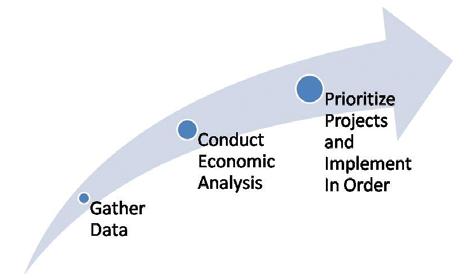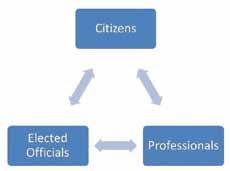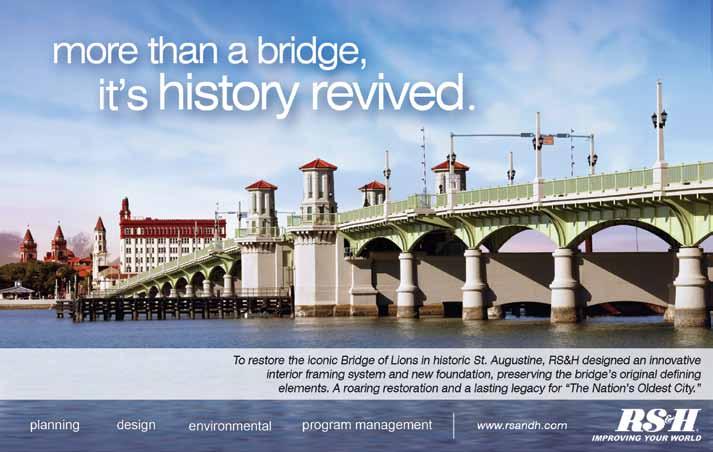
8 minute read
Project planning, engineering priorities and political decision making
Dennis Randolph, P.E., Director of Public Works, City of Grandview, Missouri, and member, APWA Engineering and Technology Committee; Joanna Johnson, Managing Director, Kalamazoo County Road Commission, Kalamazoo, Michigan
or most public works professionals a major task is to provide ranked lists of recommended projects to governing and policy boards. Because there are always far more needs than funds, the public works profession has developed sophisticated methods to help us to make these lists. Often we base these methods on the best engineering tools we have and try to inject a high degree of rational thought into them.
Advertisement
While we currently label many of these processes asset management, we have been using similar techniques for many years. Long before the term asset management came into being, and predating the sophisticated computer supported systems we use today, public works professionals have been weighing alternatives (refer to Figure 1).
Because of the wide range of organizations that develop and support infrastructure, the types of prioritization methods that we use vary widely. In particular we find a wide variation in the way in which we assign value to different characteristics. For example, some systems may look at the cost of building a project to bring it back to a specific condition. Here we would highlight the existing condition of a particular infrastructure component (a street for example), and cost of various “fixes” to restore that component. We can then rank projects using the cost of the fixes.
Another way to rank projects might take the preceding example and advance it a step by incorporating an analysis of maintenance and upkeep costs for the street over some time period. We can then use the resulting life-cycle cost for each project as the basis for ranking a group of projects. By including maintenance and upkeep cost, we have a different view of a set of projects, and a different order of projects in the resulting prioritization lists.
As we include more and more technical factors in our prioritization consideration, the resulting prioritization lists change. While we often disagree about the value or validity of including some of these technical factors, as long as they have some basis of rational, empirical thinking we usually come together and agree on the results.
This example of multiple versus narrow perspectives within the public works community is a frequent and accepted event. More importantly, it reflects a more general situation, one that members of the public works community do not often accept.
Because the policy bodies that must accept and approve the ranked lists we prepare must consider other factors besides technical ones, there is a further set of considerations that they insert into the final prioritization process. Many of these “considerations” do not have a firm—or sometimes no—engineering basis, but represent community, humanistic or political ideals. Often, these considerations can drastically change the order of priority lists (refer to Figure 2).
With changing priorities, conflict between the public works professionals who must live daily with the results of the prioritization process and the policy makers who must deal with the electorate often results.
Occasionally the change in priorities may involve many projects in the final priority list. But usually changes only involve one or two projects. However, whether it is the entire list that is

Figure 2 – Political Decision Making Process

changed by policy makers, or simply one change, we find that any change is often a significant point of conflict between the technical professional and the policy makers.
Since policy makers have the final say in the prioritization process as well as other agency policies including budget and employment decisions, the conflict arising from the disputes between technical specialists and policy decision makers can be costly. Sometimes these conflicts lead to technical specialists finding other employment opportunities. But most often the common result is a gulf that develops between technical staff and policy makers that harms both sides. Bad relationships between the two sides then mean lost or lessened productivity that harms programs. Poor relationships can also harm creativity. But most damaging is technical staff reluctance to continue to promote strong technical analysis of projects, and inclusion of technical considerations in the prioritization process.
That we want to minimize or avoid such situations is clear. How we go about doing this boils down to the question public works professionals must ask which is, “How much is enough?” That is, if we provide a list of priorities to a policy making body of 10, 20, 50, or even 100 projects and that body accepts the list substantially as presented with, say, one or two changes, should we not consider the entire process a success, rather than a failure (refer to Figure 3)?
In baseball, a star hitter may only get a hit three or four times out of 10. Likewise, a superstar quarterback may only complete 60 or 70 percent of their passes. Yet in the project prioritization “game” of public works, we often find that 90 or 95 percent acceptance rate of our prioritization lists unacceptable. Then because we find this unacceptable, we are inclined to react very negatively to the policymakers/elected officials we need to work closest with.
What should success mean?
That we need to have 100 percent acceptance of our priority lists to consider our work a success is a fallacy we in public works need to overcome— especially when we consider that infrastructure development and maintenance, by their nature, are endless tasks. It is only fitting that we should evaluate “success” over a long period of time.
We should also consider the form of the process we follow. That is, success should be tied to including a community’s values into our process, and acknowledgement by the community itself that the priorities and final shape of the developed infrastructure reflect the values, needs and wants of the community. Most important to this idea is that the values be broader than just engineering factors, but should reflect the social, economic and environmental concerns and needs of a community. The basic tenant of public administration theory “The Iron Triangle of Public Administration” (refer to Figure 4) reflects the interrelationships that exist in a community that shape a community’s values.
Just how these non-engineering concerns are factored into the priority process can be done in several ways. Adjustment of engineering priorities by policy makers is one longstanding way this can be done. But as mentioned earlier, most public works professionals consider such “adjustments” to be heavy-handed” and “politically motivated.” However, there is an alternative that often provides reasonable, even satisfactory results.
A broad-based community planning effort with regard to infrastructure allows not only consideration of technical considerations, but also the social, economic and environmental community values to be considered. Further, a good infrastructure planning efforts provides:
Figure 3 – Value of Projects Implemented
• Time for coordination that allows the community’s values to be identified and weighed before applying them in a prioritization process

Figure 4 – The Iron Triangle of Public Administration
• Time for technical, non-technical, and policy-making individuals to discuss their concerns and have a complete airing of their ideas.
The idea behind such a planning effort is to recognize that with regard to infrastructure everyone has interests, and the idea is to consider not just “technical” interests, but all the other interests of the community. More important, for the public works official, integrating a complete set of community values into a prioritization process means that there is more likelihood that the final prioritization list submitted to a policy-making organization will be accepted with few, if any, changes.
In conclusion, it is important for public works professionals to understand exactly what a “good decision” by a policy-making organization is. That is, a good decision means that: • The prioritization process used is based upon a rational process anchored in theory validated in empirical studies • The final list makes the most (but not necessarily all) people happy • The prioritized list of projects addresses (but not necessarily satisfies) all the minority opinion concerns
Too often, public works professionals expect that they have the final say in the development of a community’s infrastructure. Consequently, any approval that does not correspond to their recommendations completely is not deemed acceptable, and is often considered a failure.
However, the technical values that public works professionals bring to the prioritization “table” are only one view of the values that an entire community considers. If we are to be recognized as “stars” then we need to understand that we gain more recognition by incorporating as wide a range of values into the prioritization process as possible. Most important, that even if some of our recommended priorities are changed by policy makers, if we can still bat 900 or 950 over a career we have outshined any sports figure.
Dennis Randolph has over 40 years of experience in the public works field, including local government experience with organizations in Michigan, Missouri and Virginia. He has B.S. and M.S. degrees in Civil Engineering and an MPA. He has nearly 70 published papers and is an Adjunct Instructor at the University of Missouri–Kansas City. He can be reached at (816) 316-4855 or drand77201@ att.net. Joanna Johnson has a Bachelor of Business Administration degree from Western Michigan University. She has worked extensively in personnel placement and for the past 11 years has worked in local government managing county road organizations, parks and public works operations. She can be reached at (269) 381-3171 or info@kcrc-roads.com.

TIRED OF THE ROADBLOCKS?
APWA realizes it can be frustrating when your employment search is constantly being detoured by obstructions and dead ends. By focusing our job board solely on the public works community, we have created the best possible environment for both employers and job seekers to find each other. We help to alleviate the hassle and ensure that you are targeting the right audience each and every time.











